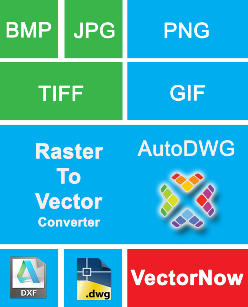AutoDWG Raster to Vector Converter, Faster than ever!
VectorNow Raster to Vector converter is a stand-alone program to convert scanned drawings, maps and images to vector files (DWG/DXF) to edit in CAD applications.
- Input image file: scanned drawings and format of BMP, JPG (JPEG), GIF, TIF (TIFF), PNG, etc.
- Output vector file: editable vector DWG and DXF, can be saved as AutoCAD R14-2022.
- Create center line and outlines
- Vectorize color, grey and black-white image.
- Solid raster vectorization supported.
Key features:
Definition of Raster and Vector
A raster graphic is an image made of hundreds (or thousands or millions) of tiny squares of color information, referred to as either pixels or dots. (Technically pixels refer to color blocks viewed on an electronic monitor where as dots refer to the ink dots on a printed piece. But even professional designers, myself indluced, often use these two terms interchangeably.)
A vector graphic uses math to draw shapes using points, lines and curves. So whereas a raster image of a 1” x 1” square at 300 dpi will have 300 individuals pieces of information, a vector image will only contain four points, one for each corner; the computer will uses math to “connect the dots” and fill in all of the missing information.
Support various source and target formats
VectorNow Raster to Vector converter is to convert raster images to vector images, supporting most popular formats, such as BMP, GIF, JPG, PNG TIF, etc for input format and DWG and DXF for output format.Create center lines and outlines.
Outlines: A vectorization method that generates lines and/or bezier curves along the borders of connected pixels.
Centerlines: A vectorization method that generates lines and/or arcs along the center of connected pixels.
Easy using and friendly settings
This converter is simple, quick and easy to use. There are only steps for the conversion and settings are friendly, usually you may use default settings.
| Discussions: |
|---|
|
1. What are the advantages of vector file?
>>
|
